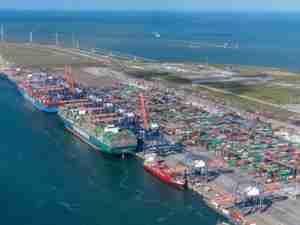
Virtually the whole of the new coastline has been sprayed on. For as long as possible, a gap will be kept open in the new sea defences so that the dredgers have free access to the area. On average, approximately eight of Boskalis and Van Oord’s trailing suction hopper dredgers are in operation for the project. Earlier this month, eleven trailing suction hopper dredgers applied 3.8 million m3 of sand in the area, in the space of one week: a new world record.
Monitoring Effects on Nature
Over the past few months, measurements have been carried out on a regular basis on the amount of silt in the North Sea and the possible impact of this on nature. After all, with the sand reclamation and sand spraying on Maasvlakte 2, extra sand and silt particles end up in the water. The quantity of particles in the water remains well within the EIR predictions. As yet, no effects on marine life have been observed. The total monitoring programme to measure such effects during the construction of Maasvlakte 2 carries a price tag of approximately €10 million.
Quay Wall for Container Terminal
In February, construction of the quay wall for the first deep-sea container terminal on Maasvlakte 2, the one belonging to Rotterdam World Gateway (RWG), began. This quay wall is being built in the sprayed-on sand, using a 40-m diaphragm wall. Bit by bit, grabs dig a trench to this depth, whilst at the same time the liquid bentonite is pumped into the hole. This ensures that the sides of the trench do not collapse. The trench is then reinforced, after which the concrete is poured. While the latter is taking place, the bentonite is pumped out. Once the diaphragm wall is standing, it is anchored on the terminal side with so-called MV piles: a type of sloping pile. Afterwards, a floor is cast at ground level. Finally, the sand can be dredged away on the port side. Things are not at that stage yet though. At the moment, the work is still limited to the construction of the first section of the quay. The diaphragm wall technique for quay walls was tried out at the Euromax terminal. The construction of the quay wall for RWG is on schedule. The first phase of the deep-sea quay will have a length of 1000 m. In addition, there will be a 500-m quay for freight barges and feeders.
Block Dam Recycled
Maasvlakte 2 will get 3.5 km of hard sea defences on the northwest side, where the waves can be high and where there is limited space in connection with the proximity of the Maasgeul. These sea defences will be able to withstand such storms as occur once every 10,000 years and they consist of:
- a stony dune to a height of NAP (Amsterdam Ordnance Datum) + 14 m with a cobble beach: a body of sand with a thick covering layer of light rubble (20–135 mm);
- a block dam to a height of NAP (Amsterdam Ordnance Datum) + 2 m constructed on the slope of the stony dune.
The low block dam causes the waves to break and the stony dune only has to cope with a much reduced swell. The slope of the stony dune requires some maintenance, especially after heavy storms. The stony dune works in virtual










